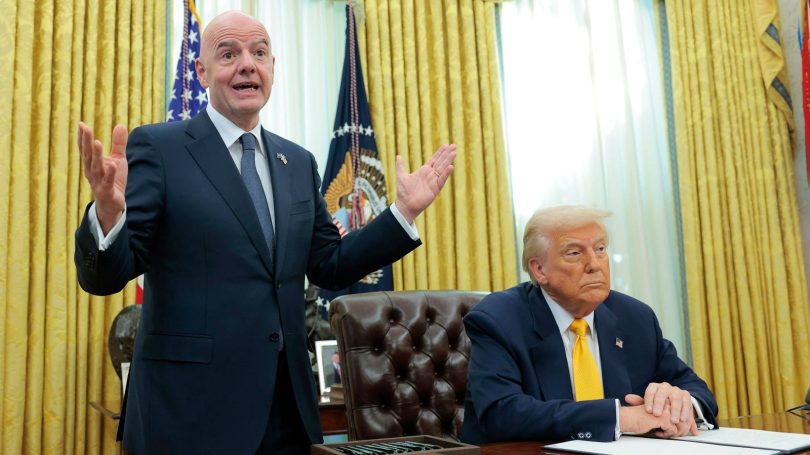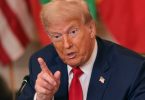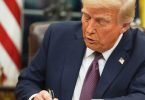Topline
President Donald Trump’s marquee legislation includes steep increases to non-immigrant visa fees that kick in next year–just as the U.S. hopes to attract World Cup 2026 soccer supporters.
FIFA president Gianni Infantino was in the Oval Office in March as President Donald Trump signed an … More
Key Facts
The bill introduces a new $250 “visa integrity fee” for most non-immigrant U.S. visas, including tourist, student and work visas, beginning in 2026.
The new fee, added to the bill by Republican lawmakers on the House Judiciary Committee, is one of 22 immigration fees in the bill designed “to encourage lawful conduct among foreign nationals visiting the United States,” but critics, including U.S. tourism officials, say it will result in fewer international visitors to the United States.
“Raising fees on lawful international visitors amounts to a self-imposed tariff on one of our nation’s largest exports: international travel spending,” Geoff Freeman, president of the U.S. Travel Association (USTA) said in a statement.
The House Judiciary Committee press office did not immediately reply to Forbes’ request for comment on the USTA’s claims.
The Trump administration is also considering significantly expanding the 12-country travel ban to more than four dozen countries, World Cup host cities in the United States that were banking on filling half their stadiums and hotels with foreign visitors could lose big.
Why Do U.s. Tourism Officials Say The Visa Integrity Fee Is A Bad Idea?
U.S. tourism officials argue that anything that makes it more difficult or expensive to visit the United States can be a deterrent to large numbers of visitors. International visitors spent $254 billion on U.S. travel and tourism-related goods and services in 2024, according to the International Trade Administration. But a recent study from the World Travel & Tourism Council (WTTC) that analyzed the economic impact of tourism in 184 countries revealed the U.S. was the only country forecast to see international visitor spending decline in 2025. “While other nations are rolling out the welcome mat, the U.S. government is putting up the ‘closed’ sign,” Julia Simpson, president and CEO of WTTC, said in a statement. As a result, the U.S. tourism industry is on track to miss out on $29 billion in tourism revenue this year. The new visa integrity fee will add $250 to a tourist’s travel bill. “These fees are not reinvested in improving the travel experience and do nothing but discourage visitation at a time when foreign travelers are already concerned about the welcome experience and high prices,” Freeman, the USTA president said, in his statement.
What Else In The Big Beautiful Bill Could Negatively Impact Us Tourism In 2026?
The bill includes $4.1 billion to hire and train at least 5,000 new U.S. Customs and Border Protection (CBP) officers and $2 billion in CBP retention bonuses to address staffing shortages at the agency. In his statement, Freeman characterized this as a win, saying additional CBP staff will “help lower wait times at airports and improve the traveler experience.” But it’s also possible that more CBP officers may have the exact opposite effect. “I think increasingly, whether there’s validity to it or not, we have to acknowledge these headlines around the world of people being detained, of their devices being searched, stories of deportation—it’s causing a degree of fear,” Freeman told Forbes in April when discussing the significant drop in Canadian visitation, adding, “And in the absence of effective communication to explain what CBP is doing, what US policy is the fact that we want you to come we’ve allowed this negative publicity to run rampant.”
How Much Tourism Revenue Is At Stake For World Cup 2026?
In March, FIFA projected the World Cup 2026 will drive $30.5 billion in economic output in the U.S., according to an analysis by OpenEconomics (OE). But that number was predicated on the assumption the U.S. will see an “influx of visitors” from foreign countries to fill stadiums and hotels. FIFA has told World Cup host cities to expect a 50/50 split between domestic and international visitors, multiple host city tourism officials told Forbes. Philadelphia expects the six matches it hosts next summer to draw 500,000 visitors and fill more than 100,000 hotel rooms to the tune of $305 million in direct tourism spending and $770 million in total economic impact, Meg Kane, chief executive of Philadelphia’s World Cup organizing committee, told Forbes in June. Kansas City—which is hosting four group stage matches, a round of 32, and then a quarter final—is expecting to draw 650,000 visitors over the course of the tournament and an estimated $653 million in direct event impact, Pam Kramer, chief executive officer of KC2026, the nonprofit organization leading the city’s World Cup planning, told Forbes.
Why Is Trump’s Relationship With Fifa Controversial?
On Monday, FIFA announced it is a tenant in Manhattan’s Trump Tower, seen by Trump critics as an example of the sitting U.S. president co-mingling his role as head of state with his business interests. “On behalf of myself, on behalf of New York, on behalf of the Trump Organization and everybody that works in this building – we love you,” Eric Trump said in remarks at a public relations event attended by former Brazilian soccer star Ronaldo. FIFA president Gianni Infantino’s coziness with Trump has drawn criticism from international soccer organizations. In May, the Union of European Football Associations (UEFA) excoriated Infantino for arriving late to the FIFA Congress in order to meet with Trump during his Middle East tour, accusing the FIFA chief of putting “private political interests” ahead of his commitment to soccer. Infantino was a guest at Trump’s inauguration in January, has attended White House meetings and has been a vocal supporter of the president. FIFA did not respond to Forbes’ request for a statement regarding the visa integrity fee.
Tangent
The Big Beautiful Bill also slashes the budget of Brand USA, the country’s public-private destination marketing organization, from $100 million to $20 million. USTA said it is “deeply concerned,” noting that “for every $1 spent on marketing, Brand USA adds $25 to the U.S. economy,” and warning such drastic cuts will “significantly impact every sector of our industry.”
Further Reading
How A 48-Country Travel Ban Could Suppress U.S. Tourism In A World Cup Year (Forbes)










